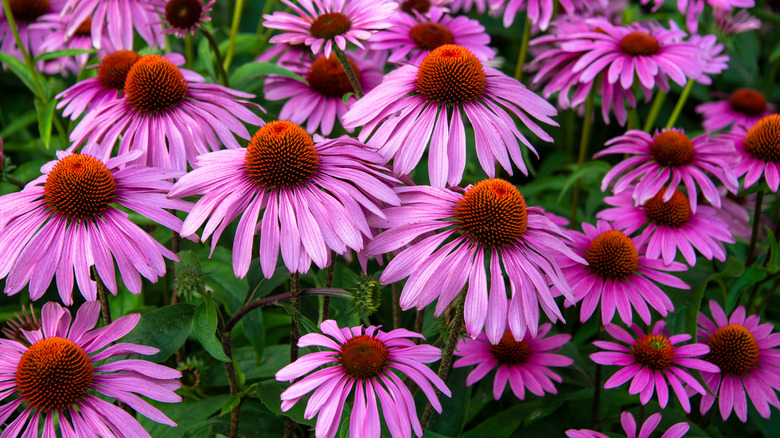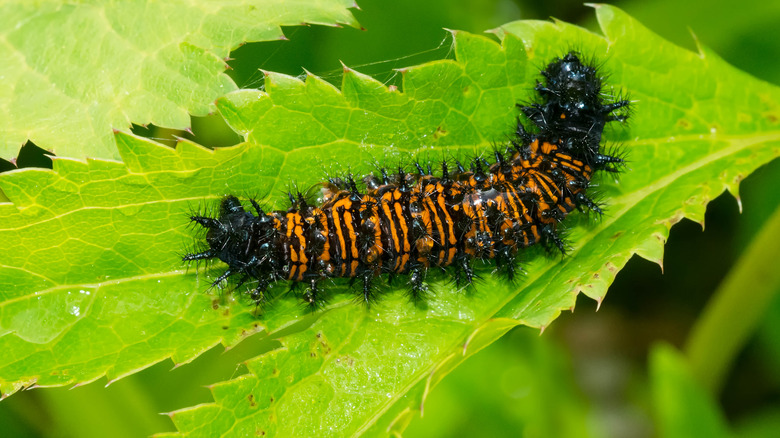11 Common Pests That Are After Your Coneflower & What To Do About Them
Local to the central and eastern US regions, coneflowers (Echinacea spp.) have garnered mass appeal and ground in many gardens (up to zone 3) that match their site requirements. That's because they add textural contrast to the mixed or perennial beds they're a part of through their serrated, stiff clumps that withstand strong breezes. Teeming with crowds of nectar-rich, gorgeous purple, pink, or white flowers, they attract the attention of diverse pollinators, including honey bees, bumble bees, and butterflies, all summer long. Plus, if you let them set seed, they'll lay a sumptuous winter buffet for a plethora of songbirds, lending immense wildlife value.
However, growing and caring for coneflowers isn't as facile as it's marketed to be, especially when it's grown beyond its native range. In addition to a range of abiotic disorders (typical to most ornamentals) and diseases, including the much-despised aster yellows, botrytis, and powdery mildew, they suffer at the mandibles of a changing roster of pests through the growth season. From aphids, leafhoppers, and rabbits to tiny eriophyid mites and caterpillars, there are plenty of undesirable guests eyeballing coneflowers, as you'll discover below.
1. Aphids cause yellowing foliage
Coneflowers' foliage and stems are often colonized by minute, soft-bodied aphids, such as brown ambrosia and green peach, though the red-colored Macrosiphum genus can be problematic, too. You'll usually find them congregating on the leaves undersides, sapping the plant of its juice while the ants farm their excreted honeydew. However, you may become cognizant of the infestation only after the leaves turn yellow or when the plant grows stunted. To get rid of aphids, hose them down with cold water, but if their population multiplies, apply neem or horticultural oil. Shear and trash the aphid-laden stems.
2. Leafhoppers cause aster yellows
Tan-bodied aster leafhoppers (Macrosteles quadrilineatus) pose a problem due to the phytoplasma bacterium they host, ultimately infecting the coneflowers with aster yellows during their sap-sucking session. Aster yellows disease shows up as green, tufted blooms (botanically, witches brooms), premature wilting and yellowing, underdeveloped plants, and plant death. Regrettably, there is no remediation, except for removing the infected plants to give the others a fighting chance. Going forward, promptly eliminate weeds, as they shelter such microbes. Place row covers around coneflowers to keep leafhoppers out. Insecticidal sprays may be essential in areas with significant pest pressure.
[Image by Xpda via Wikimedia Commons | Cropped and scaled | CC BY-SA 4.0]
3. Coneflower rosette mites deform flowers
Although eriophyid mites are usually hard to spot on coneflowers, given their tiny size and knack for homing inside flower buds, you may spot them as white dust on the tips of the florets, especially if they're present in significant numbers. They extract the cell fluids while the plants bloom, marking their flowery centers or sides with unsightly, leafy structures, much like aster yellows disease, without the systemic damage. They impede self-seeding, too — clip and bag the deformed flowers, lest the mites move on to prettier prospects. Treat with Spiromesifen if the problem persists.
4. Sunflower headclipping weevils deflower coneflowers
Some headclipping weevils (Haplorhynchites aeneus) have seemed to hop off the sunflower train to terrorize purple coneflowers and their growers around the Great Plains area. When the plants are busy exploding into flowers, weevils take the opportunity to mate, lay eggs, and chew through the stems supporting the flowerheads, slicing them off or leaving them dangling by a thread. That's because their larvae hatch out only after the florets hit the ground, overwintering there. While the damage is mostly cosmetic, seed production may take a hit. Cut off the infested blooms to break the cycle.
5. Sunflower moths muck the flowers
If the central cones of your coneflowers appear black or muddy, sunflower moths (Homoeosoma electellum) might be the likely culprits. These silvery insects inject their eggs into the new blooms, where their green larvae pupate, weaving silk as they burrow into the seeds and excreting the black pellets or frass, giving your flowers a gothic look nobody asked for. Worse, a rotting fungus can capitalize on plant injuries to wreak havoc of its own. To curb their spread, deadhead the damaged blooms and dispatch them to landfills. Next season, spray pre-budding echinacea with pyrethroid-based insecticide.
6. Checkerspot caterpillars defoliate coneflowers
Every butterfly was once a caterpillar, and silvery checkerspot butterflies (Chlosyne nycteis) are no exception. They feed on the coneflowers' foliage in their tot stage, leaving masticated bits in their wake. As checkerspot butterflies are important pollinators, it's best to let their spiny black caterpillars feed and pupate, and trim the chewed foliage afterward. Although the perennials will look hideous for a while, they'll eventually green up. However, if their population grows disruptive, consider growing an extra echinacea as a "forage plant" and relocating the offspring to it. Rarely, crescent butterflies' caterpillars may hog coneflowers.
7. Leaf miners create speckled foliage
Denizens east of Mississippi, especially in Illinois and Florida, may notice aster leaf miners (Leucospilapteryx venustella) on their cutleaf or purple coneflowers between June and September. These brown moths burrow their eggs into the foliage, helping the young larvae weave serpentine galleries in the leaves as they feed. Eventually, the foliage may appear mottled courtesy of their excrement. The red larvae may pupate within the plant's folds in a silky cocoon until it's ready to fly out. Shield your coneflowers with floating row covers to keep the troublemakers out and strip off the damaged leaves.
8. Vine weevils destroy roots
Come spring, you might chance upon notched leaves on your coneflower plants, indicating the presence of gray-bodied vine weevils. Although the damage is mostly aesthetic, vine weevils can become fatal for the plant if their milky-white grubs have free reign in the root zone. Worse, as they're night hunters, you can verify their presence only by venturing late into the night with a candle or dimly lit torch (mobile lights will give you away) and shaking the stems over a newspaper to collect the dislodged insects. Dunk them in soapy water or trap them with glue.
[Image by Martin Cooper via Wikimedia Commons | Cropped and scaled | CC BY-SA 2.0]
9. Sweet potato whiteflies worsen leaf shedding
Sweet potato or silverleaf whiteflies (Bemisia tabaci) are a common scourge among purple coneflowers, keen on destroying their foliage and reducing plant vigor. These white-winged, yellow-bodied overeaters defecate the excess sap as honeydew, which becomes a breeding ground for black sooty mold. Other times, they induce chlorosis (yellowing leaves) and premature dropping, doubling up as vectors for precarious viruses. To get rid of whiteflies, pick them off first thing in the morning using a hand vac, freeze them for a day to kill them fully and sever the infected leaves to stem the spread.
10. Japanese beetles ruin the foliage
A scourge in the east (barring Florida), the exotic Japanese beetles (Popillia japonica) have a penchant for ornamental flowers, including coneflowers. These iridescent green-brown insects eat through the flowers and foliage, leaving them skeletonized, marring their visual appeal significantly. Fortunately, healthy plants can usually take such beating without losing their recuperative capacity — unless they're still young. Screen for the invasives in June and July during early mornings or late evenings when you can knock and drown the sleepy beetles in soapy water. In the worst cases, cover the plant with netting or spray rotenone.
11. Rabbits reduce young coneflower plants to dust
Coneflowers might've managed to resist deer to a limited extent, but rabbits present a different story (as do groundhogs, if you ask the victims). These cute bunnies nibble the leaves of newly established or still-maturing purple coneflowers, putting their survival in peril. Erecting fences around your Echinacea plants may render some protection, as will interspersing the garden beds with plants rabbits loathe, such as mountain mints, goldenrods, joe-pye weeds, or bee balms. Dousing the foliage with hot pepper sprays may deter some fuzzy bunnies.











